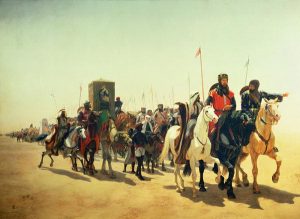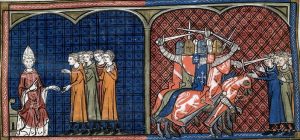The Crusades were a series of religious wars between Christians and Muslims that began to ensure control of the places considered sacred by both groups. In all, eight major Crusade expeditions took place between 1096 and 1291.

Image source: https://en.wikipedia.org/wiki/Crusades#/media/File:Richard-Coeur-de-Lion-on-his-way-to-Jerusalem.JPG

Image source: https://search.creativecommons.org/photos/512fd1eb-6656-4c59-8518-674913ccce15
The crusades were a series of religious wars sanctioned by the Latin Church. The best-known are the campaigns in the 11th, 12th, and 13th centuries fought in the eastern Mediterranean, with the aim of recovering the Holy Land from Muslim rule. The term crusade is now also applied to other church-approved and even non-religious campaigns. These were fought for a variety of reasons including the suppression of paganism and heresy, the resolution of conflicts between rival Roman Catholic groups, or for political and territorial advantage. At the time of the first crusades, this term did not exist, and only later did it become the main descriptive term in English.

Image source: https://en.wikipedia.org/wiki/Crusades#/media/File:Albigensian_Crusade_01.jpg
The eight Crusades
There were at least eight Crusades. The First Crusade lasted from 1096 to 1099. From 1147 until 1149 there was the Second Crusade. The Third Crusade began in 1189 and ended in 1192. From 1202 until 1204 there was the Fourth Crusade. The Fifth Crusade lasted from 1217 until 1221. From 1228 to 29 the Sixth Crusade took place. The Seventh Crusade began in 1248 and ended in 1254. Finally, in 1270 the Eighth Crusade took place. There were also smaller Crusades against dissident Christian sects in Europe, including the crusades against the Albigensians (1209–29). Following Pope Urban II’s request for the First Crusade, the People’s Crusade took place, and the Children’s Crusade took place in 1212.

Image source: https://en.wikipedia.org/wiki/Crusades#/media/File:The_Crusader_States_in_1135.svg
In response to a request for help from the Byzantine emperor Alexius Comnenus, the First Crusade was launched. The Crusaders conquered Nicaea (Turkey) and Antioch took over Jerusalem and established a series of states ruled by the Crusaders. After the Muslim leader Zangī captured one of these states, the Second Crusade, called in response, was defeated at Dorylaeum and failed in its attempt to conquer Damascus. The Third Crusade, which took place after sultan Saladin conquered the Crusader state of Jerusalem, led to the capture of Cyprus and the successful siege of Acre, and Richard I’s forces defeated Saladin’s at the Battle of Arsūf and Jaffa. Richard signed a peace treaty with Saladin to allow Christians access to Jerusalem. The Byzantine Christian city of Constantinople was sacked in the Fourth Crusade. None of the following Crusades were successful. The end of Crusader rule in the Middle East was marked by the capture of Acre in 1291 by Sultan Māmluk al-Ashraf Khalil.
The Knights Templar
After Christian armies captured Jerusalem from Muslim control in 1099 during the Crusades, groups of pilgrims began to visit the Holy Land. Many of them were robbed and killed as they passed through Muslim-controlled territories. Around 1118, a French knight named Hugues de Payens created a military order along with eight relatives and acquaintances, calling it the Poor Companions-Soldiers of Christ and the Temple of Solomon—later known as the Knights Templar.

Image source: https://en.wikipedia.org/wiki/Knights_Templar#/media/File:Battle_of_Cresson.jpg
With the support of Baldwin II, the ruler of Jerusalem, they established their headquarters on that city’s sacred Temple Mount and pledged to protect Christian visitors to Jerusalem.
How the world changed after the Crusades
The Crusades slowed the advance of Islamic power and perhaps prevented western Europe from falling under Muslim sovereignty. Crusader states extended trade with the Muslim world, bringing new flavors and foods to Europe. The Crusades had a strong impact on the development of Western historical literature, bringing many chronicles and eyewitness accounts. However, Constantinople never returned to its former glory after being sacked by the Fourth Crusade, and the schism between Eastern and Roman Catholic Christianity was further entrenched. The Islamic world saw the Crusaders as cruel invaders, which generated mistrust and resentment towards the Christian world.

Image source: https://en.wikipedia.org/wiki/Crusades#/media/File:Combat_deuxi%C3%A8me_croisade.jpg
Info source:
https://www.history.com/topics/ https://www.britannica.com/event/Crusades https://www.history.com/topics/middle-ages/crusades https://en.wikipedia.org/wiki/Crusades
